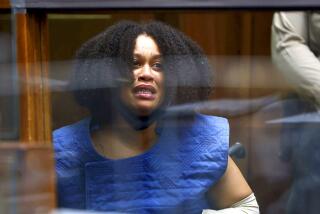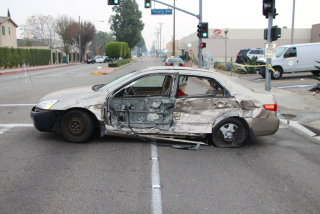When life came crashing down
George Damaa awoke after a seven-day coma in Cedars-Sinai Medical Center in 1995, his body shattered for reasons he couldn’t remember.
The last thing he recalled was driving up Pacific Coast Highway on a warm Saturday in February with the top down on his sports car and his girlfriend, Lisa Bucher, in the passenger seat. They were headed to the former PierView Cafe & Cantina in Malibu, one of Damaa’s favorite restaurants.
As he lay in the hospital, he learned that his pelvis was broken. Six of his ribs were broken. His arm was broken. And he had brain damage from a concussion. Pumped up with painkillers, his thoughts were jumbled.
But his problems were just starting.
The next day, Det. Joseph Jakl of the Los Angeles County Sheriff’s Department came to Damaa’s room and wanted to know what happened.
He told Jakl that he could not remember the crash but that he thought he was in bumper-to-bumper traffic and had turned left. That statement would prove critical.
Jakl was not taking a simple accident report. Damaa’s Mercedes-Benz 500SL had slid across the center line and collided with a Buick Reatta, killing John Masterson -- creator of “The People’s Court” and “Queen for a Day” -- and his wife, Mary. Bucher had also died.
Jakl was investigating whether Damaa had acted with negligence and violated one or more sections of the California vehicle code. If so, he would be charged with manslaughter.
There was no evidence of alcohol, drugs, extreme speeding or street racing. Damaa, of L.A., had a clean driving record and no criminal background.
“I had never been in trouble before,” Damaa, 63, said.
None of that mattered.
In Los Angeles County, more than 700 fatal crashes occur every year. The vast majority do not result in criminal prosecution, and those that do typically involve impaired driving, illegal street-racing, blatant red light-running or road rage.
But dozens of drivers in other fatal accidents find themselves deep in the criminal prosecution system. The cases change lives and seldom leave the accused drivers or the victims’ families satisfied that justice has prevailed.
Craig Datig, a vehicular homicide expert at the California District Attorneys Assn., estimates that about 1,000 people in the U.S. are prosecuted each year for vehicular homicide in accidents that did not involve alcohol or drugs.
“The public doesn’t know the risk they are running by their everyday actions,” he said.
A momentary distraction in a car -- something as simple as a spilled drink or an unruly child -- can lead to a prosecutable accident. A criminal charge is more likely if the driver has intentionally violated the law. There are many permutations of manslaughter charges, some felonies and others misdemeanors, based on legal standards known as simple or gross negligence.
“Simple negligence is something that might be charged if you are driving at the speed limit and blow a red light,” said Tom Higgins, a supervisor for criminal prosecutions at the Los Angeles County district attorney’s office. “Gross negligence occurs when you have behavior verging on reckless, without due regard for human life.”
A misdemeanor can bring a year in county jail for each death. A felony based on gross negligence can bump the sentence up to six years for each death, assuming no alcohol or drugs were involved.
In California, the number of such criminal prosecutions is rising, in part because the state has aggressive legal standards and in part because, prosecutors say, advances in accident investigation technology allow them to more precisely understand the causes of fatal accidents.
“They are the saddest cases we ever see,” Higgins said, referring to his customers who are model citizens one day and criminal defendants the next. “Every time I file one of these cases, I think, ‘There but for the grace of God go all of us.’ ”
Holding drivers more accountable for their actions should make highways safer. But the Damaa case also shows the difficulty of doing that when no one can determine exactly what went on inside a car just before a crash.
Damaa, an immigrant from Lebanon, was general manager of Downtown L.A. Motors, running eight dealerships in Los Angeles for his wealthy uncle. He was initially charged with three felonies for the crash, and prosecutors wanted him to plead out the case. His attorney, the late Charles English, pushed Damaa to agree.
“I refused,” Damaa said. “I said I would plea bargain if it were my fault. I could not even remember doing it.”
The charges were reduced to misdemeanors, and prosecutor Elizabeth Lippitt, now an L.A. County Superior Court judge, took the case to trial in Malibu on Feb. 18, 1997. Damaa was accused of violating four sections of the vehicle code, including being on the wrong side of the road. There was no question he was on the wrong side of the road, but why?
Though Damaa told Jakl he was turning, there was no place to turn at the accident site, no intersection. The other side of the road has some open space on the shoulder, but is blocked by utility poles, fire hydrants and electronic boxes. And there was no traffic jam.
Detectives assumed Damaa was lying about the traffic jam and telling the truth about turning left, or perhaps he was making a high-speed U-turn.
Damaa later said the left turn must have occurred a few miles earlier, when the couple stopped at another restaurant to see if they could get a table. It sounded to detectives as if he was changing his story.
In her opening statement, Lippitt speculated that Damaa was trying to impress his girlfriend by making a high-speed turn or a U-turn. The trial would introduce no evidence for that motivation. Near the end of the 10-day trial, Lippitt acknowledged to the judge, outside the presence of jurors, “We don’t know for sure what happened.”
A lengthy accident report initially got the crash location wrong by a full mile, showing that it occurred on a straight stretch of highway. In reality, the road curves where Damaa had crossed the center turn lane.
Detectives also had trouble finding skid marks or other physical evidence crucial to estimating the speeds and angles of the vehicles. “We did the best we could with what we had,” Jakl said in court. Both vehicles were traveling 45 to 55 mph, based on Jakl’s computations. The posted limit is 45 mph.
Witnesses in four cars saw the accident.
One witness driving behind Damaa said he saw a large cloud of smoke come from under the Mercedes just before it veered out of control. English, Damaa’s attorney, said the smoke was evidence of a mechanical problem. A radiator hose was found fractured after the accident. The rear wheels were locked up. And a tire rim was bent, indicating that Damaa may have hit a rock.
All of those factors could have pointed to a mechanical problem that would have cleared Damaa.
But English never offered the jury a coherent theory of how the various pieces of evidence fit together or how they could have caused the car to go out of control.
Lippitt shot holes in English’s speculation and called in an expert from the California Highway Patrol who said that a rock would have to be the size of a bowling ball to throw the car off course.
Another witness in a car driven by Elijah Skye Blue Allman, the son of Cher and Gregg Allman, said he saw Damaa turning his steering wheel left -- viewed from a distance estimated at 50 to 350 feet. The witness, Leighton Farr, said in a recent interview that he was sure Damaa was turning the wheel, but that he could not rule out the possibility that Damaa was reacting to a skid.
In a later deposition, Allman said he was too far away to see Damaa turning. The Mercedes “all of a sudden went out of control,” Allman said.
The jury found Damaa guilty, and he was sentenced to three years in County Jail. The Masterson family sued Damaa and won millions from an insurance policy held by the dealership. Damaa sued English, alleging that he bungled the defense, and Mercedes-Benz, alleging that a defect caused the car to go out of control. Both cases were dismissed. He also appealed the conviction, relying in part on new evidence developed by veteran accident investigator Robin T. Harrison.
The car went into a spin, but never departed from a straight line and crossed the center line only because the road curved, Harrison found. If Damaa had turned, the car could never have ended up in the position it was in after the accident, a computer simulation showed.
Harrison concluded that the car lost control because a piece of road debris hit the right front wheel and caused the Mercedes’ traction-control computer to incorrectly apply braking to the rear wheels, throwing the car into a spin.
Proving that a computer malfunction causes a vehicle to lose control is nearly impossible, although it is well established that auto manufacturers, including Mercedes-Benz, were plagued in the 1990s by electronics glitches in their early control systems, said Clarence Ditlow, executive director of the Center for Auto Safety.
Damaa “was railroaded,” Harrison said. “I have spent my life doing accident reconstruction, and the police regularly lead the charge in lousy accident investigation.”
The appeal and a subsequent request for a new trial were denied.
Damaa served two years in the county’s Twin Towers Correctional Facility, earning a year off for good behavior. After he got out, his life spiraled downhill. He never worked again and today remains obsessed with the case. In several interviews about the crash, he broke down crying.
“It has remained a mystery why he can’t let it go,” said Dr. J. Victor Monke, a psychiatrist who has treated Damaa since the accident.
The crash left Damaa with post-concussion syndrome, which affected his memory and changed his personality, Monke said. He remains deeply depressed and remorseful, Monke said.
The Mastersons’ children have little sympathy.
“It is a pity they couldn’t get him for felony manslaughter,” said Tucky Masterson, the couple’s daughter. “He never accepted any responsibility whatsoever. He never apologized.”
Sean Masterson takes a slightly different view.
“I am sorry he still lives this,” he said. “Imagine how I feel.”
--
More to Read
Sign up for Essential California
The most important California stories and recommendations in your inbox every morning.
You may occasionally receive promotional content from the Los Angeles Times.











